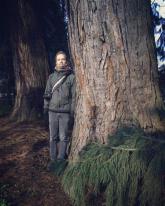Max Lindmark

Research
I use statistical and mathematical models to study ecological impacts of climate change to improve our understanding and management of marine ecosystems.
Specifically, my research focuses mainly on:
- Impacts of climate change on species distributions
- Climate effects on the growth, body size and size-structure of fishes
- Spatiotemporal modelling of ecological processes
- Dynamics and structure of size-based food webs using process-based modelling (for this line of research, I’m also involved in the FishMIP)
Background
Education
Dec 2015-2020
Ph.D. in Marine Ecology, Swedish University of Agricultural Sciences: Climate change impacts on fish communities –how species interactions and fishing mediate physiological responses to climate change
Aug 2014-Sep 2015
MRes Applied Marine and Fisheries Ecology (Distinction), University of Aberdeen
2011-2014
BSc Biology (2:1 equivalent), University of Gothenburg, Sweden. Majority of courses completed with pass with special distinction
Selected publications
Lindmark, M., Ohlberger, J., Huss, M. and Gårdmark, A., 2019. Size‐based ecological interactions drive food web responses to climate warming. Ecology letters, 22(5), pp.778-786, https://doi.org/10.1111/ele.13235
Lindmark, M., Audzijonyte, A., Blanchard, J. L. and Gårdmark, A. 2022. Temperature impacts on fish physiology and resource abundance lead to faster growth but smaller fish sizes and yields under warming. Global Change Biology, 28(21), 6239–6253, https://doi.org/10.1111/gcb.16341
Lindmark, M., Ohlberger, J., and Gårdmark, A. 2022. Optimum growth temperature declines with body size within fish species. Global Change Biology, 28(7), pp. 2259–2271 https://doi.org/10.1111/gcb.16067
Lindmark, M., Anderson, S. C., Gogina, M., Casini, M. 2023. Evaluating drivers of spatiotemporal variability in individual condition of a bottom-associated marine fish, Atlantic cod (Gadus morhua). ICES Journal of Marine Science, 80(5), 1539–1550 https://doi.org/10.1093/icesjms/fsad084
Lindmark, M., Karlsson, M., and Gårdmark, A. 2023. Larger but younger fish when growth outpaces mortality in heated ecosystem. eLife, 12, e82996. https://doi.org/10.7554/eLife.82996
Links
Publications list:
